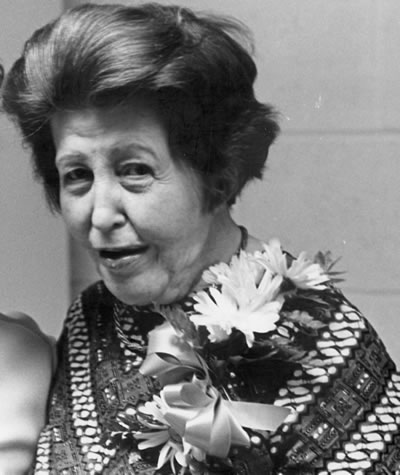 |
| “Minnich’s knowledge of blood cells grew to legendary proportions.” |
Virginia Minnich was born January 24, 1910, in Zanesville, Ohio. She graduated with a bachelor’s degree from Ohio State University in 1937 and earned a master’s degree from Iowa State College in 1938.
Minnich’s expertise was in hematology and nutrition. She studied iron metabolism, platelet function, abnormal hemoglobins, thalassemia and morphology/hematology. He work led to the discovery of hemoglobin E and the elucidation of the glutathionine synthesis pathway. She also created wide-ranging audiovisual programs on all aspects of blood and bone marrow, which have been used worldwide.
Minnich spent her entire medical career at Washington University School of Medicine, starting as a hematology research assistant in 1939. In 1958, she was promoted to research associate. She was elevated to full professor in 1974.
Minnich spent 1964-65 in Turkey on a Fulbright Award. She was a member of the Foundation for Clinical Research, the American Society of Hematology and the International Society of Hematology.
A devastating childhood fire that severely scarred her face and upper body largely shaped Virginia Minnich’s career. Drawn to the medical field due to her multiple reconstructive surgeries, she was dissuaded from attending medical school by teachers and close associates who insisted that her deformities would scare prospective patients. While working as a technician in hematology, she met Carl Moore, M.D., who later convinced her to come to St. Louis to set up a lab with him. Under Minnich’s supervision, a nationally known program was established, training students, fellows and technicians.
| “Women who were born early in the twentieth century forged their careers in the face of overwhelming obstacles. They were told at every turn that they did not belong in science. Most of those who dared to ignore this message remained essentially invisible and unrecognized. A tiny minority, however, found a niche here or there to carry on their work, and with persistence and luck they eventually entered mainstream science.” |
| The Door in the Dream by Elga R. Wasserman Joseph Henry Press, 2000 |
An accomplished morphologist, Minnich was known as the “Queen of the Blood Cells.” Her knowledge grew to legendary proportions. As a result, she was asked to set up hematology programs in Cuba, Thailand and Turkey. Typical of her research intuitiveness and curiosity, while in Thailand she noted the extremely high incidence of thalassemia. These observations led to her discovery of the abnormal hemoglobin E. Scientific acumen and dogged persistence were also evident in her later uncovering of the glutathionine synthesis pathway.
In recognition of her many accomplishments in research and teaching, she was appointed professor of medicine in 1974. Minnich was the only such professor without a medical or doctoral degree.
Always active in encouraging young people to consider careers in science or medicine, Minnich left her entire estate to Washington University School of Medicine to be used for student scholarships.
